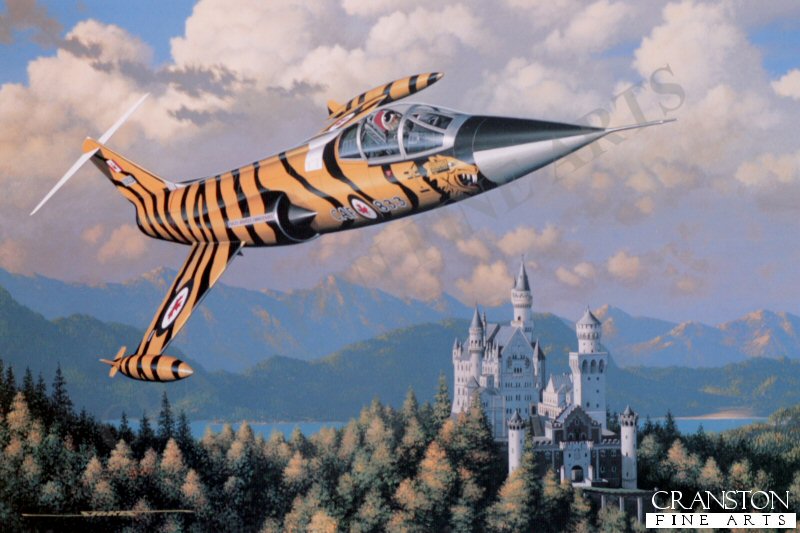- Sku:
- Vendor: Military Aviation Art Prints
Last of the Starfighters by Stan Stokes.
The introduction of the Mig-15 by Communist forces during the Korean War, came as a shock to military planners in the United States. The Mig-15 showed some superior attributes even when compared to the F-86. This rude awakening increased the Air Forces interest in a new generation of fighters which would be faster and more maneuverable than any enemy aircraft which would be encountered; a true air superiority machine. Clarence Kelly Johnson, Lockheeds innovative designer who would be involved in many of the most innovative aircraft designs of the century, had been thinking along these same lines, and in late 1952 the company submitted an unsolicited proposal for a new fighter, the XF-104. An initial contract was placed for prototypes, and the first flight took place in 1954. The F-104 was unlike anything the Air Force had previously flown. A long thin needle nose, a bullet-like fuselage, a small, thin mid-fuselage mounted wing, and an unusual high mounted horizontal stabilizer characterized this revolutionary design. The XF-104 attained a speed of Mach 1.7 during its flight tests, and the Air Force gave a go-ahead for production once meaningful quantities of the J-79 engines became available. The first production Starfighters reached the Air Force in February of 1956. The fuselage was lengthened by nearly six feet to accommodate the J-79. The first large production order was for 146 F-104As. These aircraft could carry wing mounted missiles, and had provision for an internal cannon. Troubles with the gun system were never really solved and most of these first F-104s were never equipped with the cannons. The simplicity of operation of this aircraft and its phenomenal speed made it an ideal interceptor, and this capability was appreciated during the Cuban Missile Crisis in 1962. Lockheed had meaningful success marketing export versions of the Starfighter shipping significant quantities to Pakistan, Italy, Germany, Greece, Japan, Taiwan, and Jordan. American military planners were disappointed with the range of the F-104. Recognizing this, Lockheed continued to refine and improve the aircraft. The F-104C was the second major variant and first flew in 1958. The C was capable of 1,450-MPH, and had an improved range of nearly 1,400 miles with drop tanks. The C was primarily used by the 479th Tactical Fighter Wing. The 479th deployed a squadron of F-104Cs to Vietnam in 1965, where the aircraft flew more than 2,000 combat sorties before being withdrawn. The F-104s were phased out of active Air Force service beginning in the mid-60s, but many aircraft remained with Air National Guard units. The last American unit to be equipped with the F-104 was the 198th Tactical Fighter Squadron of the Puerto Rico Air National Guard. The Royal Canadian Air Force also flew the 104. Its variant lacked the cannon, which was replaced by an additional fuel tank. The RCAF flew 104s until 1986. As depicted in Stan Stokes painting, an F-104 of the 439 Squadron of the RCAF, sports a dramatic black and yellow tiger striped paint scheme during NATO exercises in Germany in 1977.
Supplied with signed and numbered certificate of authenticity.
Signed limited edition of 4750 prints.
Print size 16 inches x 11.5 inches (41cm x 30cm)
Have a question?

Last of the Starfighters by Stan Stokes.


